Meet 20 Husky Lab Mix Owners
The Husky Lab mix joins two intelligent, active, large dog breeds into one goofy yet protective canine combination.
The Siberian Husky and Labrador Retriever breeds aren’t the most natural cross. They have very different heritages, temperaments and characteristics, which play out in a variety of ways when you scramble them together.
To really get to the bottom of what you as a new owner can expect from your Huskador puppy, we’ve interviewed 20 Husky Lab mix parents, to get the real world scoop on this striking hybrid designer dog.
- Meet the Huskadors and their owners.
- Coat care, shedding and grooming.
- Temperaments and training.
- Pros and cons of life with your Husky Lab mix.
A Word of Caution
Surveys get a bias of extremes. Owners are more likely to take the time to fill in the survey if their dog is brilliant or a real struggle. This means the positives and negatives can be highlighted in the results.
Some dogs are in their teens, others are just a few months old, which will of course impact the answers too. But this range of experiences should help you to enter into life with your new Husky Lab mix with open eyes and expectations!
Meet some of the Husky Lab Mixes!
Here are some of the wonderful Husky Lab mix owners we’ve been in touch with and an overview of their gorgeous pets, in their own words:
Abraxas, Atlas and Ivory – Dramatic Dogs
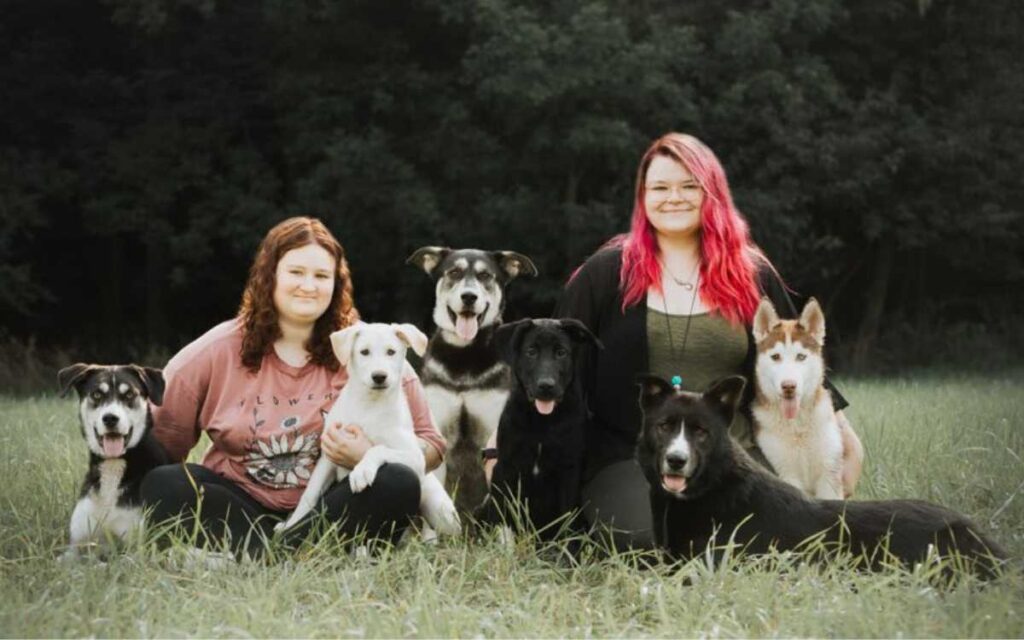
Elizabeth is lucky enough to share her life with three Husky Lab mixes, and some other gorgeous canines too.
“Apollo: looks more like a husky he has fluffy hair and the body type. Abraxas and Atlas: look like a husky with short hair because of their markings and tail. Ivory is fully white and would pass as a pure bred lab. They are all very dramatic and loud. VERY energetic, but also cuddley. They love people, but only AFTER I tell them to go near. They love cats and kittens. Very gentle with children, but not big men like my dad.”
Ranger – The Goofball
Cindy’s 8.5 year old Husky Lab mix is agouti coated Ranger.
“Ranger is built like a Lab, giant paws and block head, with Husky colors and furry belly. He has more Lab personality, funny, extremely sociable and everyone is his best friend, loves to eat everything. His Husky traits are he loves to pull a sled! He is really strong but he will never be a lead dog. If he isn’t allowed to approach someone or a dog, he gets very Husky loud, cries, jumps and spins, barks. When he is allowed to meet someone or a dog, he loves them! Everyone is his best friend.”
Maxine – The Crazy
Sherri’s buddy is 6 month old black and tan female Husky Lab mix, Maxine.
“Everyone thinks she’s a German shepherd. She’s 6 months old, so she’s firmly in her puppy stage, zooming everywhere and chewing everything. She loves everyone, tail wagging, looking to be petted.”
Maggie – The Friendly
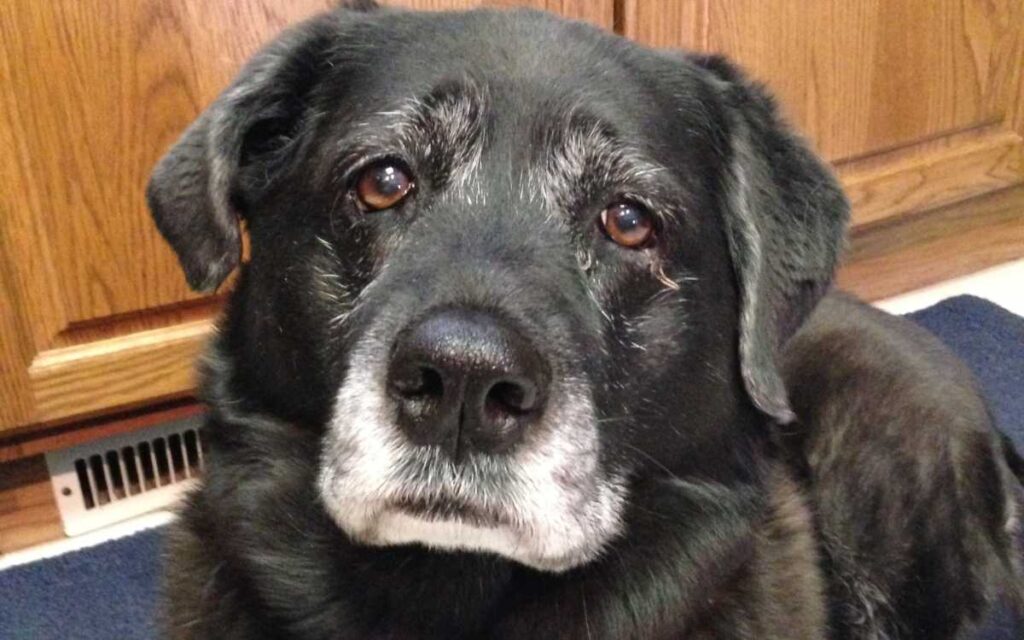
Cathy’s dog Maggie has sadly passed away, but this black Husky Lab mix was a beloved companion for nearly fourteen years.
“She had a husky coat according to the groomer. It was long and soft with a grey and brown undercoat. She had a fluffy tail that curved to her back. Everything else was lab. Liked all dogs and people. She was slightly aloof in that she didn’t need to be around us every second, which is the opposite of our full lab, who wants to be close all the time. She also was a runner and had to be fenced or tied, which is more the husky trait. And she was so gentle even though she could be easily excited. Curious about everything. The boarding kennel called her Miss Maggie and wrote a tribute when she passed.”
Reaper – The Warm
Carlie’s Husky Lab mix Reaper is 2 years old, and has a black, yellow and white coat.
“He’s very sweet and stays by my side always. If stand up, he stands up. If I sit he sits. He’s a very loyal doggy boy and thinks he is a small pup but actually is a very large 80lb baby. He is 2 years old. Either wants to play or isn’t phased by them at all and pays them no mind.”
Seto – The Goofy
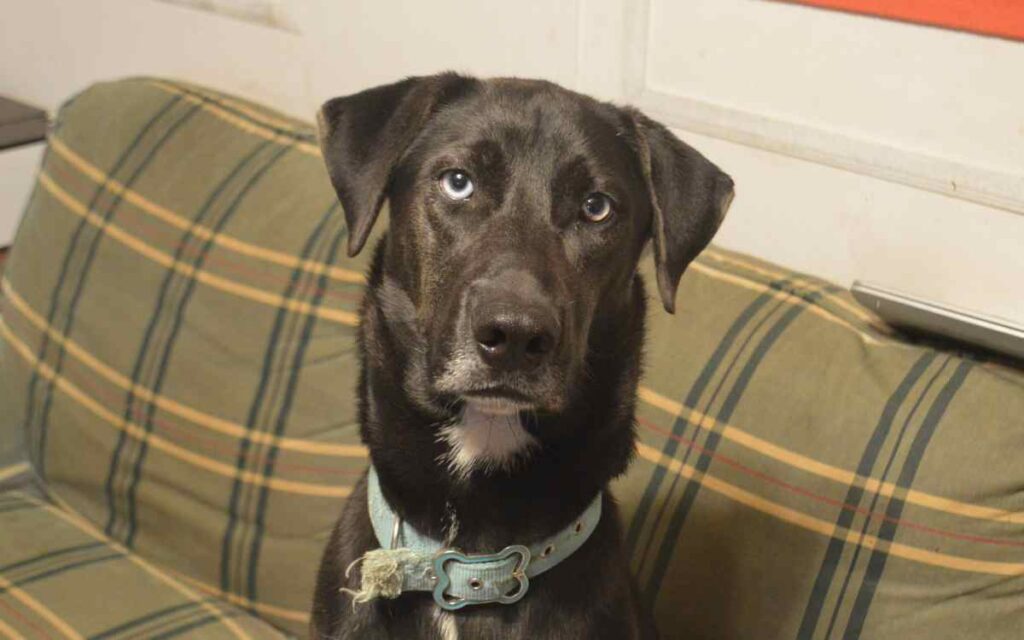
Vivi’s one year old black, white and brown male Labsky is Seto.
“Seto looks more like a lab though he has a fluffier coat and some markings similar to a husky. He is a very goofy guy, very curious about everything around him, very protective even though he’s also a bit skittish. Seto is skittish of strangers and reactive to dogs he does not know.”
Cody Blue – Goofy and Loving
Deb’s Labsky is yellow and white two year old male Cody Blue.
“His body is lab and his head is husky. We adopted him from a friend of my sister who had adopted Cody from a shelter in September, so we don’t know which parent was the dad or mom. He definitely doesn’t like other dogs so we keep him away from them.”
Fox – The Loving
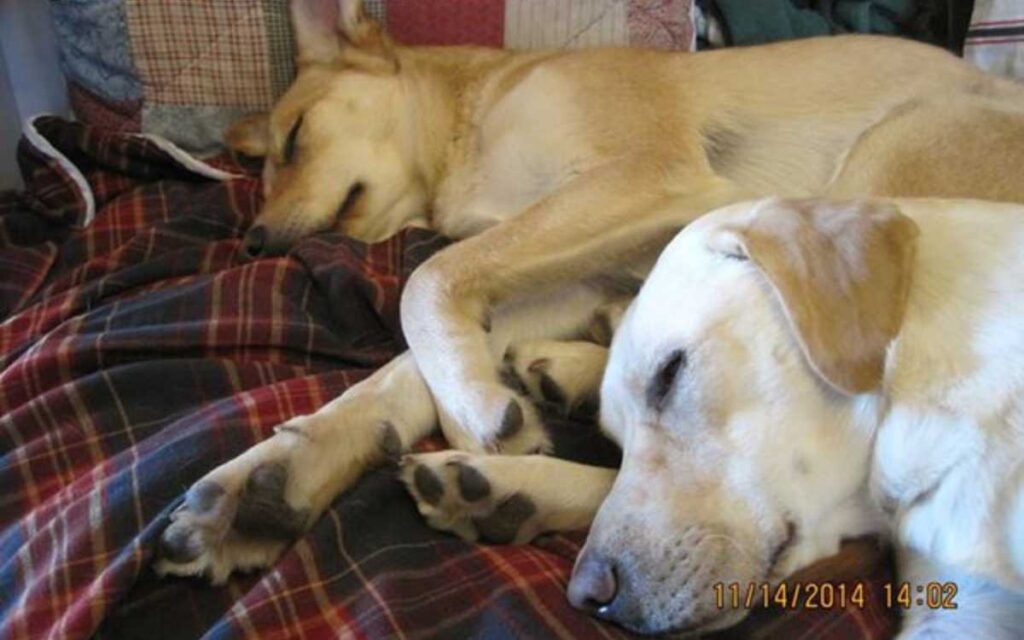
Williams’ auburn Husky Lab mix is ten year old Fox.
“Initially, she started out being afraid to the point of being aggressive. This would be due to her being dropped off at a large dog shelter before we adopted her. Now she is very lovable and talkative. She hates being alone in a room. She ignores other dogs and people, but if I stop she will be friendly and affectionate.”
Coco – The Inquisitive
Tamsin’s black and white female Huskador Coco is three years old.
“She looks husky in appearance with the husky markings and coat. However she has lab ears that lay flat – unless she’s trying to blend in with her husky pals -, and a lab tail that doesn’t curl up but is fluffy like a husky. She’s also got one blue eye and one brown. The most wonderful, loving, sweet, fun-loving, cheeky, adventurous girl. She’s playful. Can be aloof – she’s selective about which dogs she’ll play with. She can be stubborn and quite superior. Independent and knows what she wants. But also responsive, certainly to treats as she’s very food driven but also well trained. She doesn’t like to be left alone.”
Sarge – The Independent
Judie’s dog Sarge is four years old and white coated.
“Lab, but 117 lbs, one blue eye, and very hairy. He is very handsome! He is obedient when he chooses to be, loves treats, loves to play. Has a ball he likes to put in his food bowl when eating, and loves ice cubes in his water. Does not like to go into narrow places (such as behind a chair) for his ball, and will wait for you to retrieve it for him. Will bark at strangers driving in, but does not act vicious. Can trust him alone in house to wait for us to get home. Loves to play with his toys, especially squeaky ones.”
Common Husky Lab Mix Personality Traits
Every single owner surveyed described their dog as loving, and almost all of them were also tagged as excitable in our temperament trait options.
Three quarters of the Husky Lab mixes of varying ages seemed to like being together, love everyone they met and half of them were labelled as gentle.
Nearly half of the Husky Lab mixes surveyed were considered by their owners to be:
- Bouncy
- Energetic
- Confident
- Independent
- Food lover
- Loves children
- Keen to please
Calm, protective and relaxed traits also came up about a quarter of time.
A few of our lovely Husky Lab mixes struggled more socially than the others. Four were described as a combination of reactive, nervous, shy of strangers, nervous of children and submissive in nature.
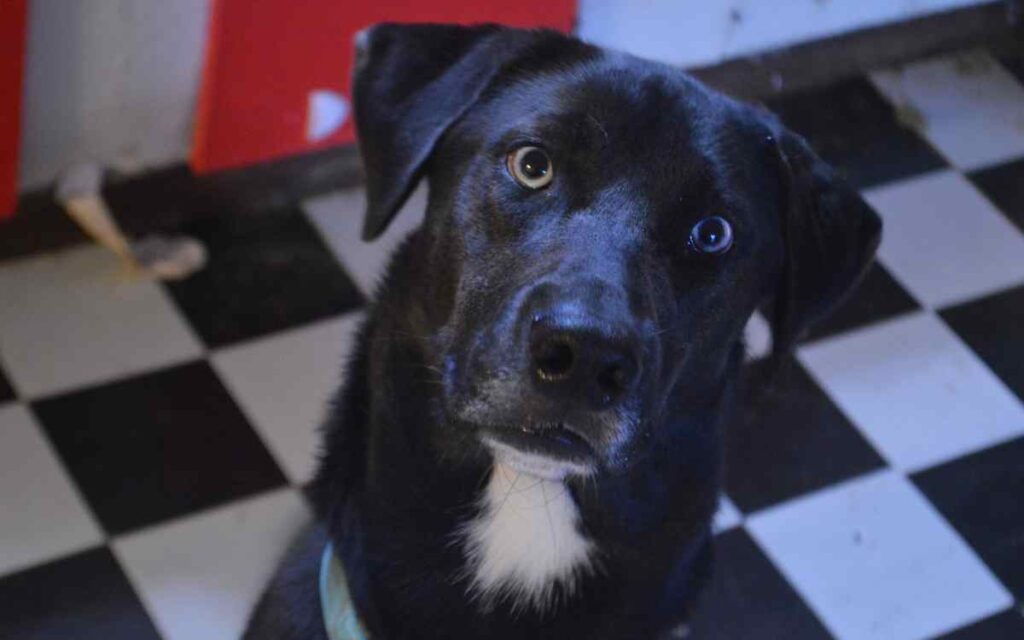
We Asked Our Owners –
Does your dog’s coat need any special or regular care?
This is not a low maintenance, hypoallergenic puppy. It was generally agreed that the bathing and grooming needs of a Husky Lab mix are high. Shedding gets more enthusiastic as the dogs age, and they can be prone to getting smelly if not regularly bathed.
All the owners agreed that this mix needed extra brushing during the shedding seasons, and one even needed clipping during summer due to developing heat sores on their abdomen.
Have you done much training with your pup? Would you say they are easy or hard to train?
This mix is undeniably intelligent, attached to their handler and motivated by food. Which generally makes for a very trainable dog. Yet there was a big range in the amount of training that our Husky Lab mix parents had undertaken with their dogs. And a huge amount of variation in how trainable they considered their pup to be.
Most of the Husky Lab mixes had basic training down, although they were generally agreed to be a bit stubborn and to suffer from selective deafness on occasion.
It was lovely to see how many puppy parents went down the positive reinforcement training route, and worked with their dogs using reward based training with plenty of success.
The dogs whose owners had tried more traditional Husky style training sessions like sled dog work, and more traditionally Lab oriented agility tasks, the dogs had thrived. Trick training, more often associated with modern training methods, has also been great for a number of our Huskador volunteers.
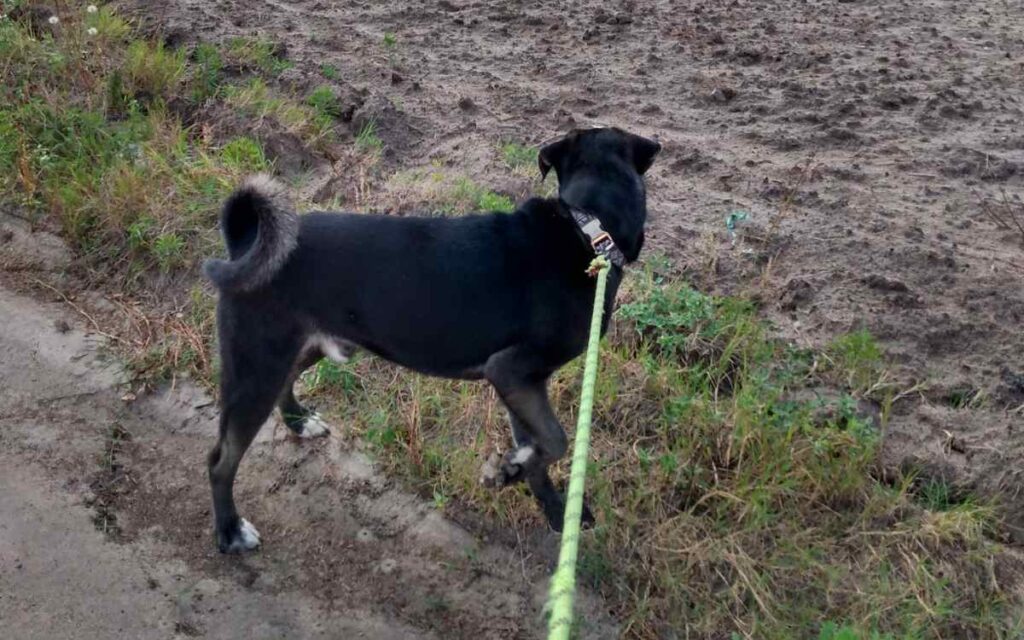
Is your Husky Lab mix happy to be left home alone for a few hours, a few times a week?
Most of our Huskadors were happy to be left alone at home for a few hours, especially once they entered adulthood and if they had the company of another dog. However, a couple of them really struggle in this area. Over-excitement upon the owner’s return, howling and generally sad body language were all experienced by some of the Huskador’s families.
Is your pet healthy?
Health issues our Husky Lab mixes experienced included some things that are common to every breed, such as parasites.
They were generally noted as healthy dogs, however allergies, particularly food allergies, and accompanying digestive issues were pretty high considering the small sample size. Nearly a quarter of the dogs were noted as having these issues and one dog was on a special diet to help deal with them.
One owner also found occasional signs of ear and eye irritation.
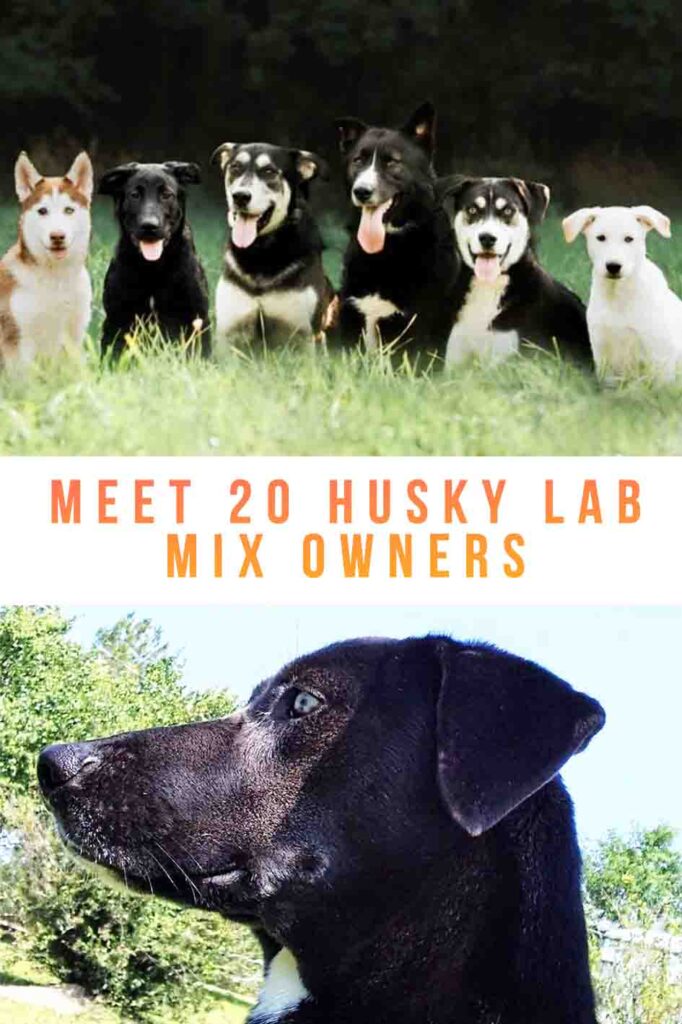
Is there anything you find hard about life with your Husky Lab mix?
Some of the reasons our Huskador owners found life with their dog hard were I think common to every dog owner at some periods of their life. Financial worries, dealing with mud and fur, as well as issues with doggy daycare provisions were raised. One dog was also sadly very afraid of fireworks.
However some problems were more closely linked to the parent breeds of this mix. High energy levels, strong pulling, over-excitement, howling and shedding all came up a lot as drawbacks.
What do you love most about life with your dog?
The most common answer to this was one word – Everything. Which was lovely to read. Despite some challenges, most of the owners that shared our survey are clearly besotted with their pet.
Sweetness, protection, energy, a calming influence. Company, comfort, laughter and love. There were so many reasons these dogs are clearly treasured and add to their owners lives.
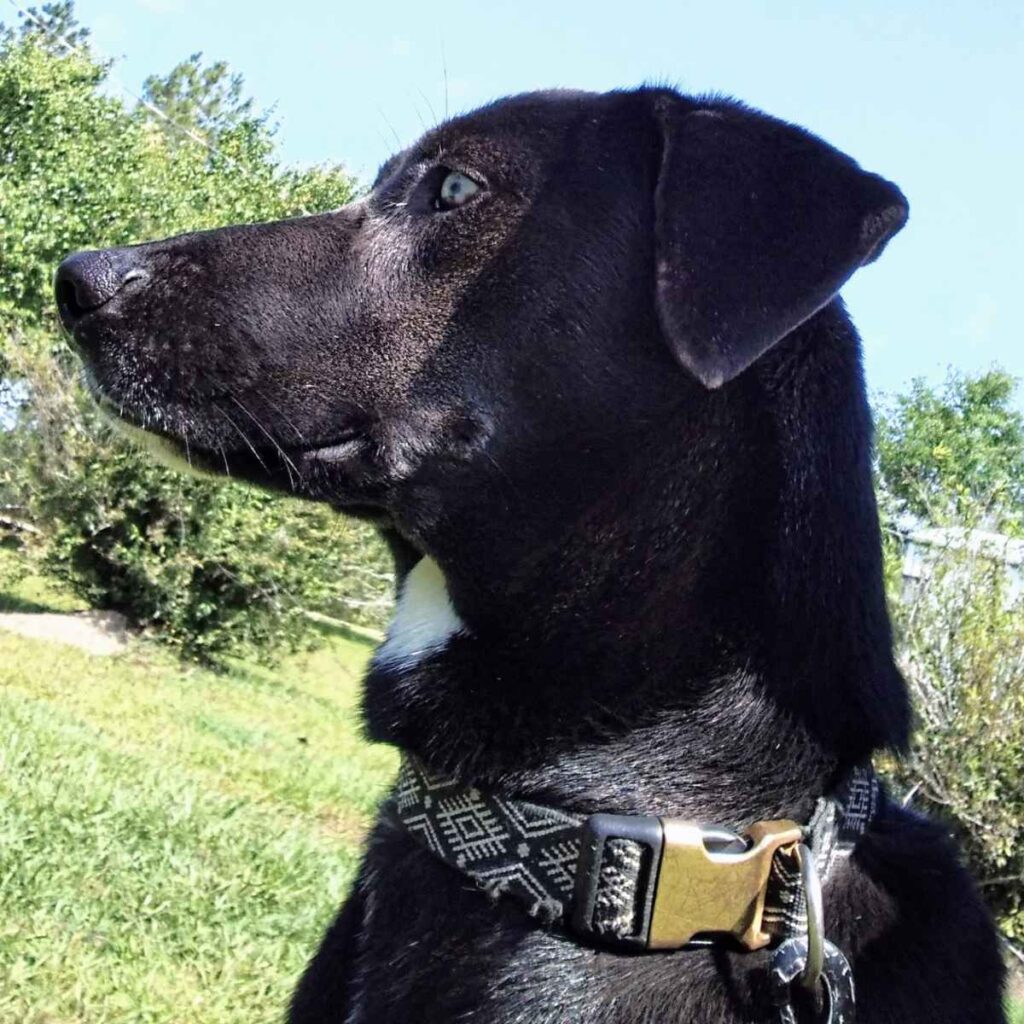
Lastly…is there anything you think prospective owners should know, about life with this Lab mix?
I’ll let these words of advice speak for themselves, they obviously come from the heart:
Ranger’s owner Cindy says:
“There is no definition of a Husky Lab mix personality. They can have either personality or a mix of the two. There will be a lot of hair!”
Barney’s owner Eva says:
“Before they mature they tend to munch through anything they come across. It just needs patience. By the age of two they stop chewing stuff.”
Reaper’s owner Carlie says:
“I highly recommend husky mix. Very fun loving dog.”
Atlas, Abraxas and Ivory’s owner Elizabeth says:
“Have the TIME and the SPACE. All dogs will be a “bad” dog if you are a BAD owner. All dogs will be good if you give them what they and their breed needs. These dogs need to run.”
Storm’s owner says:
“Don’t get this breed if you aren’t prepared to constantly stimulate their minds, you have to be able to put the work in and teach them new things and find new ways for them to play and commit the time to long walks twice or three times a day.”
Lilly’s owner Karen says:
“Labs are pretty friendly but huskies can have a stubborn streak so be prepared to expect unpredictability at times… She will swim with us and loves that. Mostly fetches. I would say out of all the dogs that I’ve had and mostly labs this dog is the most well behaved.”
Seto’s owner Vivi says:
“They will be both the worst and the best of both breeds so it can be a lot to handle if you don’t have experience with said breeds.”
Coco’s owner Tamsin says:
“Make time for exciting walks, every day where possible, and expect 3 walks a day. Not barkers but can do a beautiful howl. The best possible companion!”
Coco’s owner Jet says:
“It’s been a great mix for me. I feel that I get the best of the lab and the best of the husky.”
Sarge’s owner Judi says:
“Just love him.”
Holly’s owner Honey says:
“Hard to train and hyper, but sweet and loving, loves to be outside, loves snow and water”
Fox’s owner William says:
“Selective hearing – she will obey commands if she feels like it!”
Maggie’s owner Cathy says:
“Make sure they are secure. But overall, a very fun, easy, but energetic time. Very friendly around people and dogs. I never had a concern. I loved that pup!”
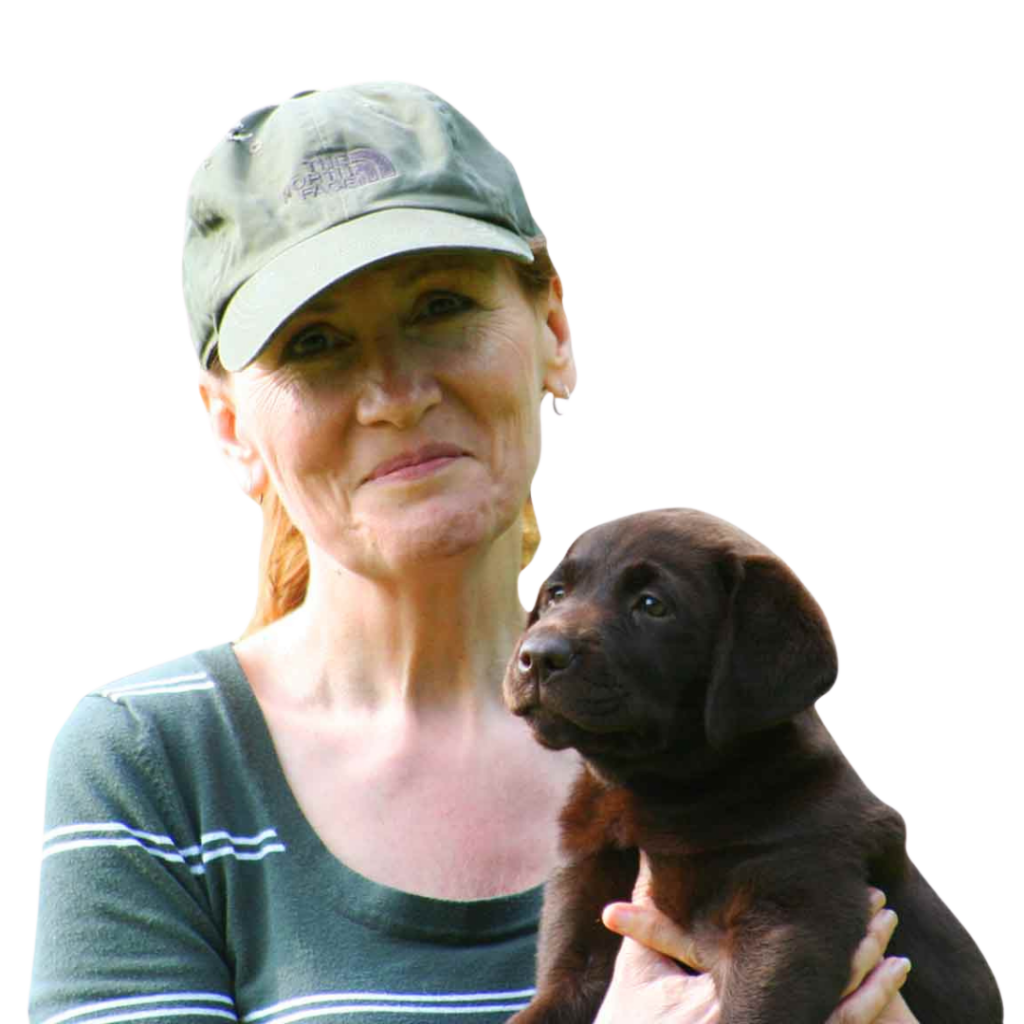
Free Labrador Updates!
Get my training tips, news, reviews, and the latest from The Labrador Site delivered to your inbox
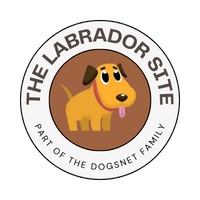
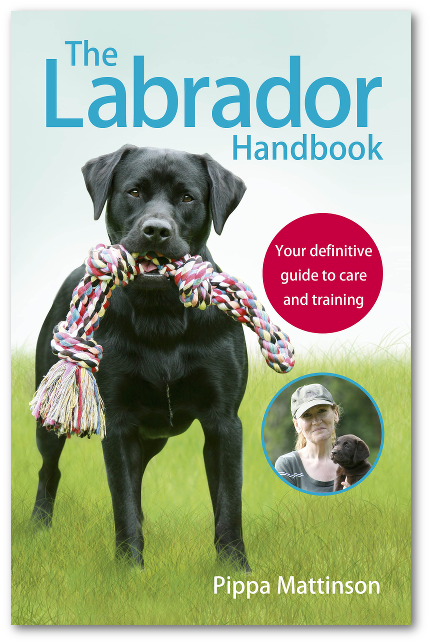

I just rescued what I thought was a Border Collie mix but turns out he’s Husky/Lab/Australian Cattle Dog and super mutt. He’s only 4 months old a little nippy but very smart and loving. He loves to play and splash in the water so far. Gets along so well with my Pyr/Husky/Shepherd mix.
I have a 6 year old chocolate lab-husky named Fiona. She was part of an accidental litter at a former coworkers house. Her mom went into heat and the husky from next door broke through the fence to get to her.
My baby is beautiful, affectionate, sweet, and listens very well. She barely barks (usually only if our other dogs start barking first) and is very polite when she wants something. If she wants up on the bed for instance, she puts her chin on the edge and stares at you while slowly wagging her tail. If you don’t notice, after a few minutes, she’ll make a tiny little woof to get your attention. She loves to cuddle, and wants to be right next to me wherever I am. She has been great with many other dogs, cats, babies, and even chickens and ducks (after much training). She learns easily and is eager to please. She loves meeting new people and new dogs. She is eager to run and play. But she is also just as likely to curl up on the floor and snooze for hours.
As a puppy, I had two issues training her. She would howl incessantly when she was in a crate for any length of time and she chewed a ton. Her chewed her leashes and harnesses up. She chewed up her dog beds. She cannot have any toy softer than a tough chew Kong or nylabone because it will be in pieces all over the floor in just a few minutes. She has stolen a few t-shirts and eaten the arms off of them. My mom called her Teeth for the first 6-8 months of her life because of it. She did grow out of all of that and now loves crates and almost never tears up anything. She also very rarely digs,, and usually only does so to find toys because our German shepherd mix likes to steal all of the toys and go hide them in the yard. She does not like water. She will not go swimming. She does like playing with mud however. Luckily, she is very good about bathing. She is a bit of an escape artist. For the first several years of her life, she was trained to walk with me off leash. But then, we lived with a pomeranian who loved to run away and go exploring. He taught her to do the same. Thankfully, she has always returned of her own accord whenever she has run off, but she is no longer allowed to be off-leash because of it. On one such escapade, she managed to get pregnant, and had a litter of 5 puppies 4 days after she turned 4. She was an excellent mom and took fantastic care of the puppies. They are all healthy and happy to this day, and I get regular updates on them as all but one went to various family members. She also handled the pregnancy and nursing very well, with no conplications or issues at all. Unfortunately, there were multiple dads involved and we only know what one of them was – a collie mix. Two of the puppies look like hound dogs, one looks like a full black labrador, one has the shape of a husky with a white coat and black spots, and the fifth looks like a squat Rottweiler. Two of them inherited their mothers blue eyes, and all of the boys got the curved husky tail. All of the puppies ended up having personalities much more like a husky than anything else, with varying levels of energy. She very rarely talks like a husky. Only when she is incredibly excited or when she is asleep. Listening to her talk in her sleep is one of my favorte things.
She does have some health issues. She was born with a large overbite. Luckily, her teeth and jaw shape grew in such a way that it barely impacts her and did not require doggy braces. It occasionally makes it difficult for her to pick up small objects off of flat surfaces, but overall, it’s barely a thing. She is also large, weighing in at 72 pounds as of two weeks ago. All of her puppies save one grew to be larger than she is by 15 pounds or more. She is surprisingly not obese or even much overweight for her frame. She’s just very dense and muscular. She spends all day running around and playing with our German shepherd and German shepherd mix.
As I said, her coat is a deep brown chocolate color. She has white toes on her front feet and a white stripe running down her chest and belly. As a puppy, she had a white stripe between her eyes, but that has since disappeared. She has bright blue eyes (that nearly glow in the dark). Her ears are on the smaller side, and are halfway between upright and flopped down, so they stick out to the side and have a slight curve to them. Her face shape is far closer to the husky side, just slightly less angular. Her general body shape is like a lab with husky legs. Her tail is upright and slightly curved with fringe all along the bottom of it. Her fur is on the shorter side of medium length. She has the softest, smoothest fur of any dog I’ve ever pet. It always has a lovely sheen to it also. She does shed, but she actually sheds the least out of our current dogs. One of her puppies inherited her coat, but the rest have vastly different textures. Three of them have very short somewhat coarse hair, and one has a long double coat. She has very dainty little feet and the webbing between her toes is present, but easy to not notice.
Overall, she is probably the best decision I have made in the last decade and she is an absolute joy to have in my life. This is a mix I would absolutely choose to have again.
I have a huskador she is 7 years old has always been more of a laid back old soul very protective of our 8 year old daughter we got her when my daughter was a year old so they grew up together and she puts up with everything when it comes to our daughter she dresses her up and loves to run and play with her and her friends she loves all people has never chewed on anything was very easy to train to do tricks and house breaking she goes outside at least three times a day I couldn’t have asked for a better dog for what they call an oopsy meaning her mom got pregnant by a neighborhood husky and we got her for free I worked with the mother of the lady who owned my dogs mother so what I’m getting at is price don’t always matter or bloodlines sometimes the best dog is a free one and money was never the issue on getting a dog I would have paid whatever the cost and even offered a rehoming fee to the lady so she would know she was getting a good home but I rather give a home to a dog who needs one then give money to a big breeder just so they can turn a profit and keep breeding more at the end of the day I just hope for many more years with my loving cuddly furry pal and highly recommend this breed to a family with kids and even other pets as she is great with all domestic animals but can’t say the same for wild as she is a hunter when given the chance
Hi I have a yellow labski and found her in NSW , Australia as a rescue dog when she was 7 mths She is the most loving and friendly dog you could ever meet. She enjoys regular long walks and running around with our family and other dogs. She gets on well with my 2 son’s dogs whenever they visit and is still quite active but also loves to rest in the sun most of the day now she’s older.
I hope she lives a few more years and would look for another labski when we need another dog. I haven’t found any breeders in NSW Australia as yet so hope there will be some in the future.
Our family is from Northern New Jersey and we are willing to travel over 50 miles or more to obtain either a Siberian Husky/Chocolate lab puppy or a Siberian Husky/collie mix. We currently have a 7 yard old dachshund who is beyond social and friendly Other than Henrybean, last year we lost our 13 yo malamute to cancer and two months later unexpectedly lost our 9 yo female malamute Savannah to an inverted stomach within 10 minutes. My husband adopted me a German Shepard since I was inconsolable over the loss of my other two within 3 months and after 10 months this Shepard was born with a heart abnormality and suffered a heart attack and passed away. I can’t take anymore loses we treat our dogs as family they go everywhere with us and if they’re not permitted then we don’t go. I have faith that you can help us find a healthy, friendly, family oriented puppy so I can stop crying. Jeter, our Shepard was my quarantine buddy we used our large yard for exercise and he had Henrybean for safe socialization. But most of all I’m an RN who is not currently working due to several underlying conditions and I’ve had to stay home all the time. I don’t know what to do without my tv buddy and best friend during this terrible time. Please find it in your heart to help this loving family who doesn’t want to go through another loss. Please please give
I have a dachshund, chihuahua, and a labsky. The labsky is so hyper, and my little dogs are scared to death. She’s way too rough.
I think the description for this breed mix is pretty spot on, except for the “protective” part. My Labsky could not be any further from protective. Fun loving, outgoing, affectionate with every single person he meets, YES. I have been told he is “awkwardly friendly”. Ah, yes. But part of his charm 🙂
I’m glad to hear a positive review on full time workers having this breed. I was wondering what sortment of toys help keep your baby entertain while y’all are at work. Also did you use a kennel at an early age? I didn’t buy Copper I was taking care if him for my son at 8 weeks old. Needless to say he is now 13 weeks old and now i am his owner due to my son’s roommate being allergic to his dander. Any advice would be appreciated ,on the do’s n don’t on this breed. I lost my 14yr old boxer girl 9 months ago to aggressive cancer. Ima pretty sure at this point it wasn’t a roommate issue but him thinking I needed a puppy..lol
Does anyone know any reputable breeders for lab husky mixes???
Hi. Did you ever find a good breeder of labsky pups? I’m looking as well. Thank you!
My dog Hopie is about 2 years old she is a black lab and has just become pregnant by a blue eyed husky. I have been doing a lot of research on them and hoping we have a nice litter of pups coming soon.
Did adopt a lab/husky/shepperd, she is almost 5 years of age. Lovely and very active female. How much time I should spent time with her outside? I give her 1 hour in the morning running in the woods and play time. Than 1hour in the afternoon same and take her at night for a walk for 1/2 hour….I find myself so tired from all the walk and play time…does she need that much time out or can I make her time little bit shorter, thank you ? I only had small dogs like cairn terrier and the didn’t need that much time to be out. Please give me some advice, thank you ?
I have a lab husky mix I rescued from a shelter 4 years ago when he was 1. Scooby was definitely a uphill battle at one year old never being trained and being in shelters for his whole life until I adopted him. He does not like other animals at all but loves other people. He is a snuggle bug as well, sleeping on top of me while I write this. All black with beautiful brown eyes, white fur under his paws and small tufs here and there around his body, and a little brown around his neck. He does shed like crazy, let’s you know vocally when he wants something, and has a huge husky personality. I definitely would not recommend getting one from a shelter though. He was not socialized well so he does not get along with most other animals. He sits well now but needs to be pointed to the ground to lay. He is 5 now and can sit and stay while Im slowly walking away and will shake when he wants to. All together I love my first dog ever but it has been a struggle. I can see how they would be an amazing breed if you have time and get them young. But being a smart and posibly stubborn breed, be prepared for a very stressful and rewarding relationship with your new best friend.
We have a 11 year old labsky, which we got from the SPCA at 8 weeks old. Was told mother was a yellow lab and dad was a fence jumping husky. I have always told people he was a labsky and never knew this was a actual designer breed dog. Lol.
He takes after the husky in body type, curly tail and attitude. He is however one of the best dogs I have ever lived with. He is more interested in pleasing himself then us most of the time. He still acts like a pup and is very active, also one of the smartest dogs I have ever known. Love him to death and hope he lives a long, long time. Wish I could show you a photo as he is a beautiful dog with golden fur and bicolored eyes.
I have a labrador / husky dog from a rescue (not a designer dog with pure breed parents). She is yellow with bicolour eyes. She is now 18 mths and huge. I have not weighed her lately but she must be 80 lbs. She is wonderful with grand children and very affectionate. Follows me around the garden. I have been redirecting her digging to her own digging spot where I hide treats. We go to the dog park every day and as we live in Winnipeg Canada, we walk even in 30 degrees below zero weather. She LOVES snow!
I have a question. I’m a small person and a senior. When my dog, who loves to chase, gets chased by larger dogs, she runs to me and often bangs into me or the dog chasing her bangs into me. I have been knocked down 3 times this year and now am quite afraid of her running in to me. I now sit on a park bench in the dog park, but she sits by me and won’t play unless I walk with her. Can you offer any suggestions ?
I love my dog, but I’m afraid to fall and really hurt myself, which would be the end of the dog park for her. Louise
Hi Susan
Sounds just like our girl Zoe
Shd is a beautiful golden colour too with big colour eyes.
Shd id now almost 11 and I hope to have her a bit longer but she is slowing up a bit now she is older
I will be looking for another Labski but Zoe is so special she would be difficult to replace.
I hope we can find a breeder in NSW, Australia
My dogs ears were too when I got her from the shelter about 3 weeks ago at 2 months. She is 3 months now and they stand up.
My 15 year old Lab husky mix just died. What an incredible pal he has been these last 15 years. I am single and live alone and work 12 hour shifts as a nurse. My dog never ever chewed anything and was seldom incontinent in the house. He had a fenced in back yard and a doggie door which helped to give him something to do while I was at work. I also made sure we got out at least twice a week for off the leash runs/hikes in the park. We also belonged to a doggie day care center and went about 1-2x a week. This dog probably would not have been so well behaved if he had not had this chance to run and play.
I have a huskyxlab. One ear is up the other down. Will this sort itself out. she looks so dopey at the moment. Don’t mind up or down, but not one up and the other down. 🙁
Any advice is welcome.
The yellow dog looks just like my puppy. We got her from a shelter, and she was listed as a lab mix, so we have been trying to decide what she is mixed with, and she just may be a lab/husky. She loves to chew on everything and seems really sad when there’s not a lot going on. She has been very loyal to me and protective since the day we got her. She rarely barks and only for a reason, but we are having a hard time house training her. I guess only time will tell.
Have her DNA tested. It will tell you the percentage of breeds and what diseases if any she may be predisposed to in the coming years.
I disagree with the statement that a full time worker shouldn’t have this breed of dog. My husband and I both work full time outside of the home and our son is in high school. Our Chocolate Lab/Husky mix does wonderful in the house during the day. He is very excited when we get home and he has to be taken for a walk almost immediately, but with the right exercise schedule and toys to play with throughout the day, I think full time workers can have this breed and it thrive with them.
i had one his name was bear super dog. sweet to most dogs but did protect the house just lost him last week he was 13 years old and his ears were floppy. the best dog i ever had very smart. he loved my wife but if igot up at nite he got up with me. when i would take a shower he was at the door when icame out and when i came home from work he was at the window he know what time i got home from work. we would go for 2 mile walks.tell it got in the 90s to hot for him.
I recently got a Husky /Lab mix.. He is 7 1/2 weeks and I’m wondering if his will stand up… They are floppy ATM.
Where did you find the breeder for your puppy? I am located in Southern California.. looking to find a Labrador husky mix!